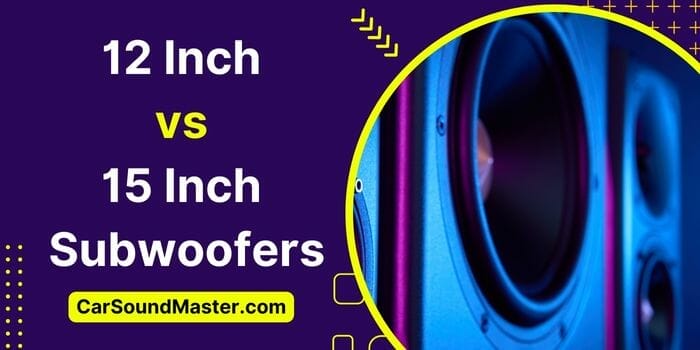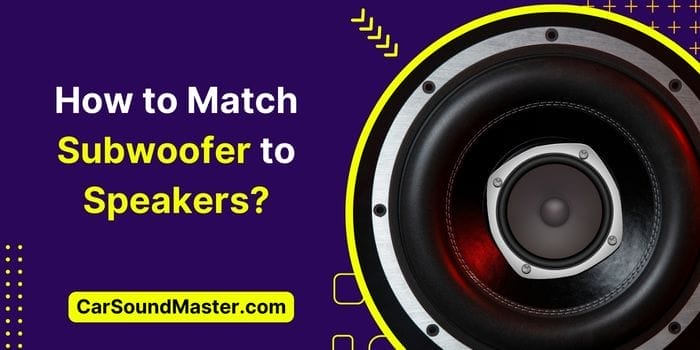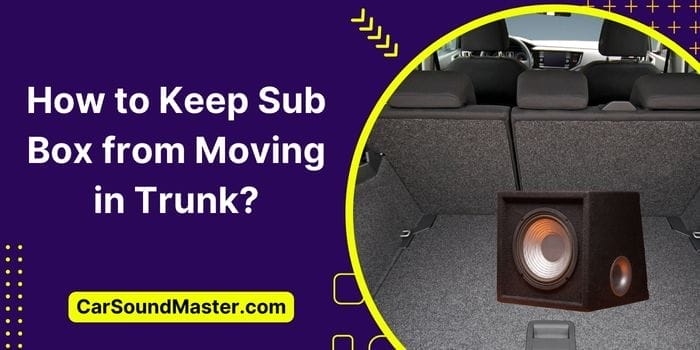Do I Need a Subwoofer in My Car? And What Size? The Untold Truth
Notes from the lowest region of the audible spectrum, also called bass frequencies, are the hardest to produce.
Meanwhile, they are the most loved ones too. After all, only the bass waves are capable to reveal on you the truest colors and the actual far-reaching depth of a melody – a melody that’s otherwise empty, tasteless, and texture-less.
And because subwoofers are the only drivers that specialize in reproducing these waves, they are the most cherished components of a complete audio system.
That said, if you’re an absolute music-mad (esp. a fan of EDM, hard rock, & hip-hop genres), you can never say “no” to a subwoofer in your car. Subwoofers put that long-lost depth and life into your music that other typical car speakers miserably fail at.
Regarding what subs size you need, I’d say the one that you can compensate enough air space for.
Didn’t get the point? Let’s understand in detail.
Do I Need a Subwoofer in My Car? And What Size?
Though enough has already been said, again, bass is the backbone of music. If you need more than just shallow sound waves, you definitely need them at work.
Meanwhile, because bass waves are the longest and superbly airtight, they need spacious surfaces and a lot of air to be moved at once to reproduce.
The standard car speakers, due to their crammed sizes, are not capable of handling that range of waves as effectively as intended.
Their lowest frequency range often ends at around 50 to 60 Hz, and they still abruptly distort even if just pushed to those levels (esp. on higher volumes).
Why Should I Get a Subwoofer for My Car? Does It Make Any Difference?
Subwoofers are specially designed speakers dedicated to producing only low-frequency sounds. They flaunt bigger cone sizes to easily move bulky amounts of air. So if you want that depth and realism in your music, a subwoofer is a must for you.
However, it’s not just that. There are a lot more other reasons why installing a subwoofer is the best thing you can do to your car’s audio setup. For example:
Emphatic, Deep, and Stable Bass
As mentioned above, those typical speakers on your car start caving in at around 50, or 60 Hz. They even find it difficult to touch those figures without distorting their shapes.
That’s why when you go high up with the volume and push them to reveal all the wider-ranging sounds in your songs, they become unstable.
On the other hand, a subwoofer can easily handle frequencies as low as 20Hz or maybe lower than your audibility.
So you not only get to hear each low note but also feel it crystal-clear no matter the volume levels; the depth element also stays exceptionally intact.
Improved Precision and Lucidity
In addition to profoundness in bass, a quality subwoofer also means excellent accuracy in those brisk starts and stops in basslines, vocals, and instrumentals.
They have the required speeds engineered into them to catch up with the fastest happening transients; they don’t overhang on notes.
So you get unbelievable preciseness and clarity in whatever frequency booms or slumps. However, as you go a bit low with the quality of the subwoofer, you may start sacrificing a tad bit on this thing.
Relieve Mains to Produce Steady and Solid Full-range Response
A separate subwoofer in your car also means a great relief from shaky highs and mids. And it applies more to the coaxial speakers.
Without a sub, if you push your coaxial/full-range mains with peak bass settings at higher volumes, the woofer cone not only distorts in the process to produce bass notes but also fails to catch up with the mids and tweeters.
The phenomenon results in not only poor low-frequency response but also unstable mid-range and high notes as well.
However, a separate sub with its crossover perfectly calibrated to the rest of the system takes care of only the bass notes to produce that quality oomph. And with that load taken off the main speakers, the sub allows them to only handle the frequencies they are best at – the lower mids, mids, and highs.
So with a separate sub installed, you get the entire audible sound spectrum stably covered and no region of sounds feels shaky or faint.
What Size Subwoofer Do I Need for My Car? What Size Subwoofer is Best for Me?
The choice of subwoofer (size) is always way too complicated a thing compared to other speakers in your car.
Unlike other speakers, subs aren’t those simple plug-and-play components. You need to be careful with a lot of acoustics settings and make sure the sub has enough airspace to its surroundings to show up with its best potential.
Make sure you factor in the following considerations and match-ups before deciding on a subwoofer for your car.
Subwoofer Sizes and Types and Your Car’s Space Availability
Subwoofers come in various sizes ranging from as small as 4” to as big as colossal 18”. Though the sizes that usually go into most of the cars out there include 8”, 10”, and 12-inch subwoofers.
Well, the choice of subwoofer depends mostly on the space available in your vehicle. That’s why you should first measure the trunk (because that’s usually where the sub goes into a car) size of your vehicle which will give you an idea about making an informed decision.
Apart from the size, factoring in the space availability also helps in making an informed decision about the sub’s type – free air or enclosed subs (i.e. sealed, ported, or IB subs).
If you have just enough space and you also don’t want to displace all the rest of the miscellany from the shelf, getting a free air sub of about 10” to 12” would make for an ideal bet.
On the other hand, if you prefer enclosed subs (due to their high-fi bass response), the same space will best compensate for an 8” to 10” sealed subwoofer.
Carrying on, if you love more booming bass and with the same impact as that of sealed subs, a ported subwoofer is what you should get. So the same space would ideally shell out for a 6” or maybe even smaller ported sub (as they need bigger cabinets for great impact).
IB (Infinite Baffle) subwoofers are a completely different story as they use the car’s trunk itself as their enclosure. So they need a lot more complex measurements before fitting in.
Nevertheless, here’s more about the car speaker sizes to help you work out plans for your car.
- 8” Subs – good for too small a vehicle and a person with too dinky budget. These subs are just good upgrades to your stocks and are not preferred for resolute and super-hitting bass performance.
- 10” Subs – just superior to the 8” Subs, these are also compact to fit almost any car. They may throw a bit of high-quality bass and may not distort as much on higher volumes as their smaller counterparts. But 10” subs are also not liked by extreme bass mads.
- 12” Subs – perfect for car-level bass needs courtesy of their excellent depth, clarity, and impact. Almost the first-choice subwoofer size for most vehicles (medium to large-sized cars and convertibles). However, these may be bigger for some too small a car, and somewhat expensive too.
- 15” Subs – designed to handle higher power levels and usually go into truck-like large vehicles. They are usually a preferred choice for pro-level audio setups and are quite expensive.
- 18” Subs – jaw-dropping with their bass performance but the most expensive (in all aspects i.e. price, power needs, space needs) of all.
More to Consider While Getting a Subwoofer for Your Car
In addition to doing the size measure and match-up, also factor in the following.
Checking Out the Car Amplifier’s Tech Details to Make the Best Match
Make sure you double-check your car’s stock amp power, impedance, and sensitivity properties before you go for the subwoofer replacement.
Check if your current amp/receiver/head unit can effortlessly power the subwoofer you’re planning to get and ensure there should be no “subwoofer getting over or underpowered” issues.
If you’re planning to get a new amp as well for the new sub(s), perfect. But if you’re planning to continue with the existing one, make sure you get a subwoofer with the same wattage and impedance ratings.
Sound Quality Preferences
Last but not least, figuring out your needs is the most essential part of landing on a tailor-made aftermarket subwoofer. Some subwoofers are only dedicated to music purposes and designed with a focus more on the bass quality and bassline distinctiveness.
Whereas, there are some dedicated to cinematic use-case scenarios where the focus tilts a bit from “bass only” towards real-time impactful reverberance, booms, and grumbles.
The size, build, and technical details of subwoofers also directly affect their sound quality. So the subwoofer that does well at all these factors is what you ideally need for your car; hopefully, it will never disappoint.
Conclusion
Closing it out, I’d suggest you bookmark this page – this very blog post – before anything like “Do I need a subwoofer in my car? and what size?” gets gobbling your head, next time. So that you can come back straight here and read it aloud again.
You absolutely need a subwoofer in your car for so many good reasons. For example, to feel the truest form of the music instead of just texture-less sound waves, to fix unclear transient responses and improve on accuracy, and to enjoy full-bodied sounds with each region of the audible range covered to its truest feel.
Easier said than done because end of the day, it all comes down to your affordability. Nonetheless, if your budget allows, a subwoofer is always needed in your car – for so many great reasons.
What size? Well, that depends on so many factors as discussed in detail above. Go give it a read.
Good Luck 🤞.






![Types and Sizes of Car Subwoofers [2024 Researched List]](https://eh5q6g75abq.exactdn.com/wp-content/uploads/2023/07/Types-and-Sizes-of-Car-Subwoofers.jpg?strip=all&lossy=1&ssl=1)
